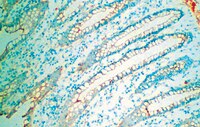Fibronectin Antibodies, Proteins & Assays
Millipore’s Fibronectin Antibodies, proteins, and assays are based on the expertise of Upstate & Chemicon. See below products related to Fibronectin research, including Migration assays & ELISA kit.
Több
Millipore’s Fibronectin Antibodies, proteins, and assays are based on the expertise of Upstate & Chemicon. See below products related to Fibronectin research, including Migration assays & ELISA kit. Kevesebb
More>>
Less<<

Recommended Products
-

1017362500 Sigma-Aldrich OSTEOMOLL® -

9230-5KG Millipore OmniPur® TRIS -CAS 77-86-1 - Calbiochem -

ABN482 Sigma-Aldrich Anti-SYPL1 Antibody -

810017 Sigma-Aldrich Probumin® Bovine Serum Albumin Crystallized, Powder -

MX0100 Millipore Maleic Acid - CAS 110-16-7 - Calbiochem -

216275 Sigma-Aldrich 5-Carboxyfluorescein Diacetate - CAS 79955-27-4 - Calbiochem -

MCVD2MAG-77K Millipore MILLIPLEX® MAP Mouse Cardiovascular Disease (CVD) Magnetic Bead Panel 2 - Cardiovascular Disease Multiplex Assay -

820452 Sigma-Aldrich Probumin® Bovine Serum Albumin Diagnostic Grade, Powder -

MABN1182 Sigma-Aldrich Anti-Glutamine Synthetase Antibody, clone 11A3.1 -

8219020250 Sigma-Aldrich 3-Metilbenzoesav
Overview
Specifications
Ordering Information
Documentation
Kapcsolódó termékek és alkalmazások
Kapcsolódó termékek gyártója: Brand Facete
| Chemicon® |
Kategóriák
| Life Science Research > Antibodies and Assays > Primary Antibodies |
Fibronectin is involved in many cellular processes, including tissue repair, embryogenesis, blood clotting, and cell migration/adhesion. Fibronectin exists in two main forms, as an insoluble glycoprotein dimer that serves as a linker in the ECM , and as a soluble disulphide linked dimer found in the plasma. The plasma form is synthesized by hepatocytes, and the ECM form is made by fibroblasts, chondrocytes, endothelial cells, macrophages, as well as certain epithelial cells. EMD Millipore’s Fibronectin related Antibodies, proteins and assays are based on the expertise of Upstate & Chemicon. All have been well validated and published. See below for data, references and related products for Fibronectin.
General Coating Procedure
1. Plates: Choice of plates can affect the amount of protein that can be coated. A plastic high binding plate is recommended.
2. Add between 1–10 µg/mL of fibronectin in PBS buffer overnight (or longer) in the cold (2–8°C) (100 µL/well). The optimum amount of protein, enough to saturate, needs to be determined depending on the lot of fibronectin and plates. For ELISA some people attach using carbonate buffer pH 9.0 but this is generally not necessary and can damage the cell binding activity of the fibronectin.
3. No matter what type of assay, cell binding, ELISA, etc. it is necessary to block the remaining protein adherence sites on the plate. Therefore, in a separate step add a blocking protein 2–5% BSA in PBS at least 1 hour at room temperature or overnight at 2–8°C (200 µL/well).
Caution: The BSA solution needs to be filtered to remove excess non-specific sticking in the assay caused by insoluble BSA clumps (RIA-grade BSA is usually recommended). Unfiltered material may look clear but the filters will clog while passing the BSA so it is recommended to use prefilters on top of the filter bed to increase the amount of material that will pass.
4. Blocked plates can be stored, as is, in the refrigerator for several weeks or can be decanted and dried and stored for months in a dessicator. Desiccated material should be rehydrated for 15 minutes with PBS before use.
Note: Generally fibronectin should be stored in the freezer or refrigerator at 1–5 mg/mL and should never be vortexed or treated roughly because it could crash out of solution and cannot be resuspended. It is also best but not absolute that it should not be stored long in buffers containing Mg2+ or Ca2+ because it can precipitate over time.






